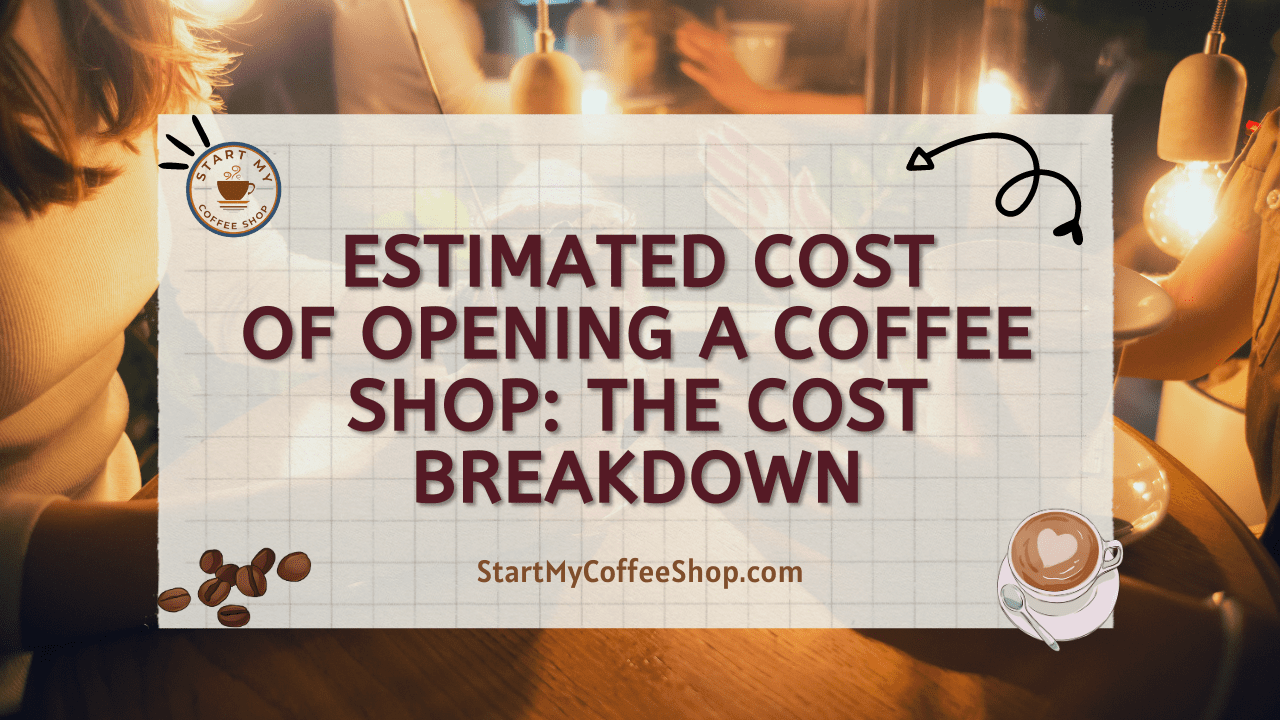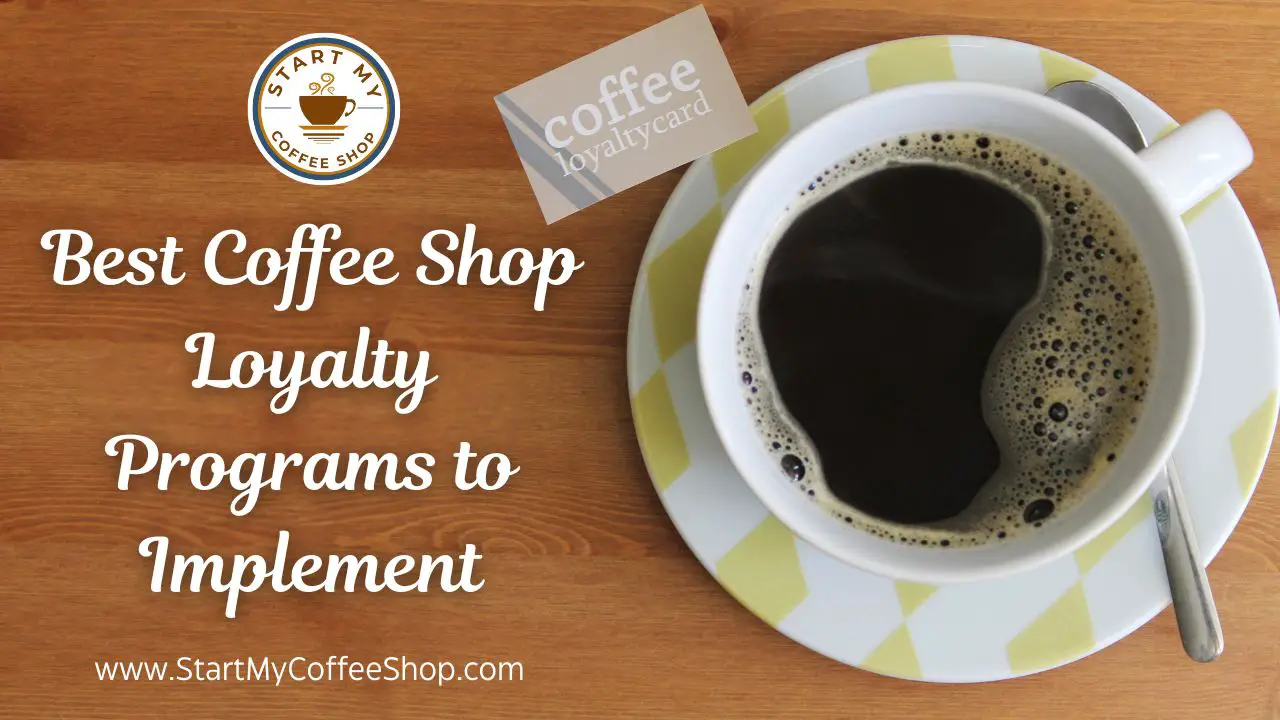The thought of crafting delicious brews, creating a cozy ambiance, and connecting with coffee lovers is undeniably enticing. However, before embarking on this exciting journey, it’s crucial to understand the estimated costs involved.
The estimated cost of opening a coffee shop, considering equipment, rent, salaries, licensing, permits, and inventory, can range from $100,000 to $500,000 or even more. It all depends on your location and the size of your dream café. So, are you ready to dive into the world of aromatic brews and frothy goodness?
In this article, I will delve into the various expenses associated with opening a coffee shop, including equipment, lease or rent, staff salaries, licensing, permits, and initial inventory.
Equipment Costs
 When it comes to opening a coffee shop, one of the most substantial initial expenses is acquiring the necessary equipment. A well-equipped coffee shop requires a range of essential tools, such as espresso machines, grinders, brewers, blenders, refrigerators, and more, tailored to your specific menu offerings. The cost of equipment can vary significantly based on factors such as the brand, quality, and whether you opt for new or used items.
When it comes to opening a coffee shop, one of the most substantial initial expenses is acquiring the necessary equipment. A well-equipped coffee shop requires a range of essential tools, such as espresso machines, grinders, brewers, blenders, refrigerators, and more, tailored to your specific menu offerings. The cost of equipment can vary significantly based on factors such as the brand, quality, and whether you opt for new or used items.
It’s important to invest in reliable and high-quality equipment that can withstand the demands of a bustling coffee shop. While prices can vary, a rough estimate for essential equipment typically falls within the range of $20,000 to $50,000. However, keep in mind that this estimate can increase if you choose more specialized or premium equipment options.
When considering equipment costs, it’s beneficial to strike a balance between quality and budget. While it may be tempting to opt for the cheapest options available, investing in durable and efficient equipment can save you money in the long run by minimizing maintenance and replacement costs.
Additionally, it’s worth exploring both new and used equipment options. Used equipment, in good condition, can often provide a more cost-effective solution without compromising on quality. However, ensure that any used equipment you consider undergoes thorough inspection and, if possible, comes with a warranty.
To determine the precise equipment costs for your coffee shop, it’s advisable to research reputable suppliers, consult with industry professionals, and create a detailed equipment list based on your menu and operational needs. This will enable you to develop a comprehensive budget and make informed decisions when purchasing equipment for your coffee shop.
Read more about Costs For Starting A Coffee Shop: Exploring The Hidden Costs
Lease or Rent
The cost of the lease or rent for your coffee shop depends on several factors, including the size of the space, its location, and the prevailing local market conditions. Typically, prime locations in busy urban areas come with a higher price tag, while suburban or rural areas may offer more affordable options.
Lease rates can vary significantly, but a general estimate for lease or rent expenses ranges from $2,000 to $10,000 per month. It’s important to note that these figures can go even higher for premium locations in highly sought-after areas. When setting your budget for lease or rent, it’s crucial to carefully consider the location and its potential foot traffic.
Choosing a location with high visibility and a steady flow of potential customers can positively impact your coffee shop’s growth. Busy commercial areas, office districts, or locations near colleges and universities often attract a significant number of customers. However, keep in mind that prime locations with heavy foot traffic may come with a higher cost.
When evaluating potential locations, consider factors such as proximity to your target market, accessibility, parking availability, and competition in the area. Conducting thorough market research and analyzing the demographics and consumer behavior of the surrounding area will help you make an informed decision.
While lease or rent expenses can be a significant portion of your overall budget, it’s essential to strike a balance between affordability and the potential return on investment. A location that aligns with your target market and offers strong growth potential may justify a higher lease cost.
Negotiating favorable lease terms, such as lease duration, rental increases, and tenant improvement allowances, can also help manage costs in the long run. Seeking guidance from a commercial real estate agent or consultant with experience in the hospitality industry can be valuable in navigating lease negotiations and finding the best location within your budget.
Staff Salaries
Common positions to consider when staffing your coffee shop include baristas, cashiers, kitchen staff, and managers. Baristas are the heart and soul of your coffee shop, responsible for crafting exceptional beverages and providing excellent customer service.
Cashiers handle transactions and ensure smooth operations at the register. Kitchen staff play a vital role in preparing food items and maintaining cleanliness and hygiene in the kitchen. Managers oversee the day-to-day operations, staff schedules, inventory management, and overall business strategy.
Staff salaries typically account for 25-35% of your operating expenses. However, this can vary depending on factors such as the local labor market, minimum wage requirements, and the experience level of your staff. It’s essential to research and comply with labor laws and regulations regarding wages, benefits, and working hours in your location.
When determining your staffing budget, consider factors such as the anticipated customer volume, peak hours, and the level of service you want to provide. Carefully assess the skills and experience required for each position and offer competitive wages to attract and retain talented individuals.
Additionally, offering employee benefits such as health insurance, paid time off, and retirement plans can help you attract quality staff and foster a positive work environment. Consider the costs associated with providing these benefits when calculating your overall staffing expenses.
Proper training and ongoing professional development for your staff are also essential investments. Well-trained employees contribute to exceptional customer experiences, increased productivity, and a positive brand reputation.
To manage staffing costs effectively, optimize staff schedules based on customer demand and seasonal fluctuations. This ensures adequate coverage during busy periods while avoiding unnecessary expenses during slower times.
Invest time and resources into hiring, training, and nurturing your staff to create a positive work culture that translates into exceptional service for your customers.
Licensing and Permits
 Operating a coffee shop legally requires obtaining the appropriate licenses and permits. These ensure compliance with regulations and help maintain the health and safety standards necessary for running a food service establishment. The specific licenses and permits you need may vary depending on your location and the services you offer.
Operating a coffee shop legally requires obtaining the appropriate licenses and permits. These ensure compliance with regulations and help maintain the health and safety standards necessary for running a food service establishment. The specific licenses and permits you need may vary depending on your location and the services you offer.
Typically, coffee shops require a business license, which grants legal authorization to operate in a specific jurisdiction. The cost of obtaining a business license can vary depending on local government requirements and ranges from a few hundred to a few thousand dollars.
Health permits are another crucial aspect of operating a coffee shop. These permits demonstrate that your establishment meets health and sanitation standards. The cost of health permits can vary based on your location and the size of your coffee shop.
If your coffee shop offers food items, you may need additional permits related to food handling and preparation. These permits ensure compliance with food safety regulations and may involve fees for initial application and ongoing inspections.
In some cases, if you plan to serve alcoholic beverages, you may require a liquor license. The cost and process of obtaining a liquor license can be more complex and expensive than other permits. It’s important to research the specific requirements in your area and budget accordingly.
When budgeting for licensing and permits, consider not only the initial application fees but also the cost of renewing licenses and any required inspections. Licenses and permits often need to be renewed annually or periodically, and there may be associated fees.
To ensure compliance and avoid penalties, it’s crucial to understand the licensing and permit requirements specific to your location. Contact your local government agencies or consult with professionals familiar with the licensing process to determine the exact permits you need and their associated costs.
Read more about Costs Involved in Opening a Coffee Shop: The Financial Journey of Opening a Coffee Shop
Initial Inventory
When setting up your coffee shop, it is essential to stock it with a wide range of high-quality ingredients and supplies. These include coffee beans, tea leaves, milk, syrups, pastries, and other items necessary to create your menu offerings. The cost of your initial inventory will depend on the size and diversity of your menu.
Collaborating closely with suppliers is crucial to negotiate favorable prices and determining appropriate quantities to avoid unnecessary waste. By establishing strong relationships with suppliers, you can ensure a consistent supply of fresh ingredients while managing costs effectively.
The estimated budget for your initial inventory can vary based on the scale of your coffee shop. On average, you can expect to allocate anywhere from $5,000 to $20,000 for your inventory needs. This range accounts for the different requirements of small, medium, and larger establishments.
When budgeting for inventory, consider factors such as the demand for specific items, seasonal variations, and your projected sales volume. It’s important to strike a balance between having enough inventory to meet customer demands and minimizing excess stock that could lead to waste.
Implementing efficient inventory management practices, such as regularly monitoring stock levels, tracking expiration dates, and optimizing ordering processes, can help reduce waste and control costs. Additionally, considering factors such as shelf life, storage requirements, and supplier reliability will contribute to effective inventory management.
Miscellaneous Expenses
When opening a coffee shop, it’s important to account for various miscellaneous expenses beyond the significant costs mentioned earlier. These additional expenses play a crucial role in creating a well-rounded establishment.
Here are some key miscellaneous costs to consider:
- Marketing and Advertising: Allocating a budget for marketing and advertising efforts is essential to attract customers. This includes strategies such as online and offline advertising, social media campaigns, website development, and promotional materials.
- Interior Design and Decor: Creating an inviting and aesthetically pleasing atmosphere is vital for a coffee shop. Budgeting for interior design, furnishings, decor, lighting, and comfortable seating contributes to the overall ambiance and customer experience.
- Signage: Invest in clear and eye-catching signage both inside and outside your coffee shop. This includes your shop’s name, logo, menu boards, and directional signs to guide customers.
- Insurance: Protecting your business with comprehensive insurance coverage is crucial. Consider costs for general liability insurance, property insurance, workers’ compensation, and other relevant policies based on your specific needs.
- Utilities: Budgeting for ongoing utility expenses such as electricity, water, gas, and internet services is essential. These costs can vary based on the size of your space, the equipment you use, and local utility rates.
- Point-of-Sale (POS) Systems: Investing in a reliable POS system helps streamline operations and facilitate smooth transactions. This includes the cost of hardware, software, and any associated fees for processing payments.
- Ongoing Maintenance: Factor in the costs of routine maintenance, repairs, and equipment servicing to ensure the longevity and functionality of your coffee shop’s infrastructure.
To cover these miscellaneous expenses, it is advisable to allocate a percentage of your overall budget, typically around 10-15%. However, the specific allocation may vary based on your business model, location, and individual requirements.
Frequently Asked Questions
How much should I budget for equipment when opening a coffee shop?
Equipment costs can vary, but a rough estimate for essential equipment ranges from $20,000 to $50,000.
What should I consider when budgeting for lease or rent expenses?
Lease or rent expenses depend on factors such as location, size of the space, and local market conditions.
How much should I allocate for staff salaries in my coffee shop budget?
Staff salaries typically account for 25-35% of your operating expenses. The number of employees needed will depend on the size of your coffee shop and the level of service you aim to provide.
To learn more on how to start your own coffee shop checkout my startup documents here
Please note: This blog post is for educational purposes only and does not constitute legal advice. Please consult a legal expert to address your specific needs.

Hi! I’m Shawn Chun
My adventure in coffee began when I first launched my first coffee shop back in the early 2000s. I had to figure out so many things on my own and to make it worse within 2 years of opening two large corporate coffee chains moved in just blocks away from me!
As I saw smaller and even some larger coffee shops in the neighborhood slowly lose customers to these giant coffee chains and slowly close up shop, I knew that I had to start getting creative…or go out of business.
I (like you may be) knew the coffee industry well. I could make the best latte art around and the foam on my caps was the fluffiest you have ever seen. I even had the best state-of-the-art 2 group digital Nuova Simonelli machine money could buy. But I knew that these things alone would not be enough to lure customers away from the name brand established coffee shops.
Eventually, through lots of trial and error as well as perseverance and creativity I did find a way to not only survive but also thrive in the coffee/espresso industry even while those corporate coffee chains stayed put. During those years I learned to adapt and always faced new challenges. It was not always easy, however, in the end, I was the sole survivor independent coffee shop within a 10-mile radius of my location. Just two corporate coffee chains and I were left after that year. All told the corporate coffee chains took down over 15 small independent coffee shops and kiosks and I was the last one standing and thriving.
Along the years I meet others with the same passion for coffee and I quickly learned that it is not only “how good a barista is” that makes a coffee shop successful, but the business side of coffee as well.
Hence why I started this website you are on now. To provide the tools and resources for up and coming coffee shop owners to gain that vital insight and knowledge on how to start a coffee shop successfully.
Stick around, browse through my helpful blog and resources and enjoy your stay! With lots of LATTE LOVE!
Shawn






